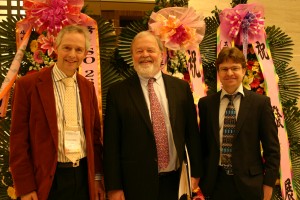02 October 2011
It is 8.30 pm and I am sitting at the ocean front bar of the Sol y Mar hotel in Puerto Ayora on Santa Cruz Island. My first impression of Galapagos is that the variance of micro climates within a short distance is remarkable, from arid, cactus strewn desert to lush humid forest.
On the way from the airport to the hotel, we stopped to see the giant tortoises. What surprised me the most was their abundance. It was almost like stumbling across a herd of cattle or flock of sheep. Their size and ancient features are incredible. Apparently, they live to 120 years and their shells weigh 250 kgs when full grown.
We also visited a volcanic cave, with a 300 m tunnel where rivers of lava used to flow. The main town hugs the coastline and I spent many pleasurable minutes mesmerized by the frigates and delighted by the occasional pelican gliding by. I already feel very calm and peaceful here, especially now as I listen to the waves lapping against the key.
Even so, I have finished by Pisco Sour and popcorn, and my pickup is as 6 am, so I will head back to my room for an early night.
03 October 2011
Today’s excursion began with a 1 hour bus ride across the island and then a 2.5 hour boat trip out to Bartholomew Island, where we climbed to the top of the volcano and then snorkelled in the bay.
The island is entirely volcanic and one of Galapagos’s newest (approximately 1 million years old, versus 5 million for the rest of the archipelago). It is like peering through a tear in the fabric of time, back to the beginning of creation. There are just a few plant species that have managed to gain a foothold on what is otherwise a barren landscape of contorted lava rock (black and rust-coloured) and lava ash.
The snorkelling was breathtakingly beautiful and I was lucky enough to see a large school of bright yellow-tailed fish, as well as a sting ray (it is so big! Maybe 1.5 metres across). I also saw small iguanas and exquisite bright red crabs. We had occasional company from frigate birds, sea longs and penguins alongside the boat, and were treated to boobies bomb-diving for fish. All in all, an exciting and relaxing day, worth every bit of the sunburn that I am now suffering with.
04 October 2011
Today was perhaps one of the most blissful of my life. In the morning, I went to Tortuga Bay and spent a few hours sitting on the volcanic rocks overlooking the lagoon, flanked on both sides by marine iguanas and blue-footed boobies. My goal was to photograph the boobies in flight, but ‘doing’ soon dissolved into ‘being’ – a feeling of at-one-ness with nature and contentment in the moment.
En route – a 45 minute walk along the beach – I encountered colonies of marine iguanas, and managed to snap a pelican as it launched to capture a fish in the shallows. I also spotted a white finned reef shark gliding past in the turquoise water, and saw (for the first time) crabs scuttling along the surface of the water between rocks about one metre apart.
I wouldn’t have believed it possible for my day to get any better. However, as I took a water taxi to a nearby beach in the afternoon, I chanced to meet Jacqueline de Roy. Since she is 85 and had several heavy bags, I offered to help carry these to her home nearby. She invited me in and we got talking. What a fascinating life she has read.
She arrived in Galapagos from Belgium with her late husband in the 1950s and never left. At the time, there were only about 150 people loving on the islands (today, the population is about 200,000). They did various things to survive, from farming (bananas) to tour operating and selling crafts (ink sketches on wood, pottery, sculptures and silver jewellery). Along the way, they helped scientists to collect snails, butterflies and moths, and even have several species named after them.
Their daughter, Tui de Roy, ended up becoming a renowned wildlife photographer, with books about Galapagos, the Andes, albatrosses and New Zealand (where she now lives). Needless to say, I was easily tempted into buying some of Angelique’s silver jewellery (iguana and penguin pendants and blue footed boobie and tropic bird earrings), as well as one of her daughter’s spectacular books called ‘Galapagos: Islands Born of Fire’.
The whole encounter was one of those rare, random meetings of strangers who open a window on each other’s lives and part mutually enriched in spirit. It reminds me of Indira and my discovery of Kookaburra Cottage in Australia. These are the golden nuggets we are sometimes lucky to find along life’s dusty pathways – the real treasures of existence.
Related Diaries
Ecuador 2011 Notes
Related Poems
Galapagos | Serenity
Share this page












